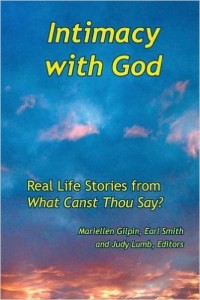Intimacy with God: Real Life Stories from What Canst Thou Say?
Reviewed by William Shetter
April 1, 2016
 Edited by Mariellen Gilpin, Earl Smith, and Judy Lumb. Producciones de la Hamaca, 2015. 181 pages. $20/paperback. $9.99/eBook.
Edited by Mariellen Gilpin, Earl Smith, and Judy Lumb. Producciones de la Hamaca, 2015. 181 pages. $20/paperback. $9.99/eBook.
Buy on FJ Amazon Store
What Canst Thou Say? is a newsletter in which Friends share their mystical experiences and contemplative practice. Each of the quarterly issues is centered on an announced theme, such as “Letting Your Life Speak,” “Touched by the Spirit,” or “Spirituality in the Workplace.” A list of the themes of all past issues is in an appendix to this volume.
After the first ten years of publication, an anthology of selected contributions was published, and this current volume now celebrates 20 years of publication of What Canst Thou Say? Each of the 114 stories in this anthology takes up on average only a page and a half, which has the happy result that thoughts are compressed into lively narratives free of digression.
The book consists of seven chapters, each representing a general theme.
“Getting Acquainted” is about the first stirrings of the Spirit, the openings toward discovery and mystery. As one writer puts it, “God’s Seed really does take root in the compost formed by working the soil of our Being.”
“Intimacy with God in Nature” shows how contributors have been inspired by aspects as varied as a landscape or a sailboat, and creatures such as a dog, a robin, a turtle, a bear, and even pinto beans. One writer is a “friend of the darkness,” the velvety dark that smooths out imperfections so that “soft darkness whispers over me and is my rest.”
In “A Committed Life,” Friends experience the ministries of giving gifts back to God in acts of prayer, hospitality, writing, fasting, vigil keeping, and prophesy. Some writers meditate on the mysteries of following leadings and of the conviction of being called.
In some respects the chapter “Finding God in Our Challenges” is the most thought-provoking, as it shows astonishingly varied paths to the Divine at our center. The challenges may be mental illness, autism, oversensitivity, the tyranny of an outsized ego, or something as simple as camping but forgetting to pack a can opener. Rising above the challenges can take the form of singing; dancing; “pecking through [my] shell, trying to emerge”; or being “stuck in a state of prayer.”
In “With God in Pain and Despair,” contributors delve even more deeply into how we can find in trauma the courage that comes from the presence of a life companion. In this chapter we find the challenges that go beyond those of the preceding chapter: physical abuse, deep shame, addiction, schizophrenia, troubling dreams of guilt. In one of the most memorable essays, divine healing comes concealed in the form of a disreputable-looking drunk.
It is in “Intimacy in the Journey with God” where realizations of God’s grace in small things are recounted: tasks, no matter how small, can be holy (Jesus washed feet and probably dishes too!), and for one writer the workplace for receiving people turns into a sacred space. It is at the same time the chapter which is most clearly focused on mystic experiences: quaking, dancing with God, the discovery that one is possessed of “second sight,” a vision of honey from the sky. Mystic experiences can truly take on almost infinite forms.
The “Celebrating Intimacy with God” contributors describe the range of ways in which mystics experience wonder. One writer once saw everything and all persons suffused with an otherworldly golden light. The most touching essay in this chapter was written by a woman who could only overcome an incident of sexual abuse by constructing a protective shell between herself and the world. This could only be penetrated by taking photographs of details: “I could put the camera protectively up to my face,” she says, “[with the result that] each photograph I took became a prayer of gratefulness.”
What Canst Thou Say? rightly calls itself “a worship-sharing group in print.” This brief summary gives little hint of the breadth of the mystic and contemplative experiences shared—a few via poems—by nearly 90 Friends. We can be grateful to the editors who, in their collective wisdom, have presented us with a colorful and deeply thoughtful selection of brief messages that feels much like being in a meeting for worship.
To subscribe, read the archives, or submit a story, go to Whatcanstthousay.org.



Comments on Friendsjournal.org may be used in the Forum of the print magazine and may be edited for length and clarity.